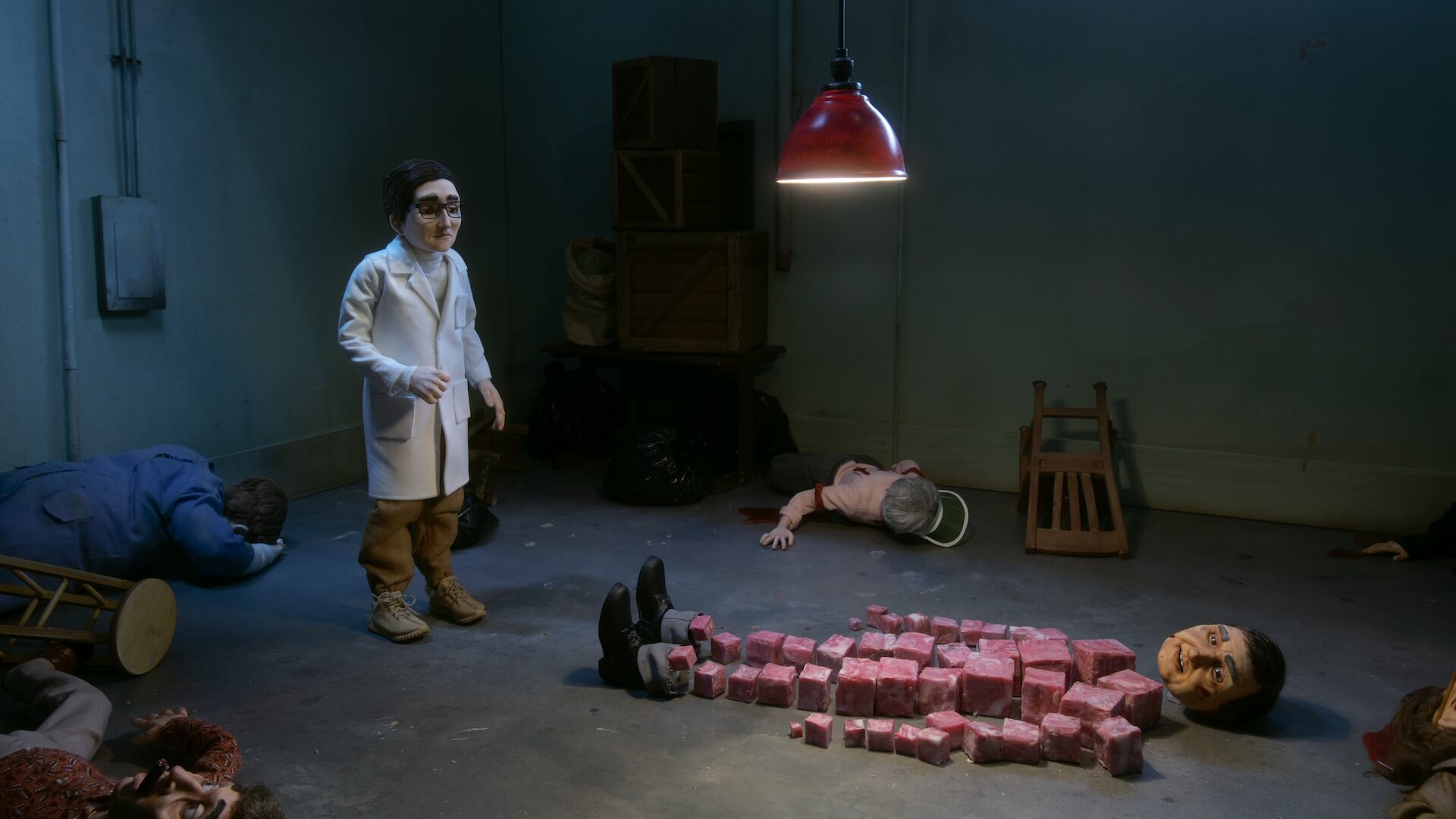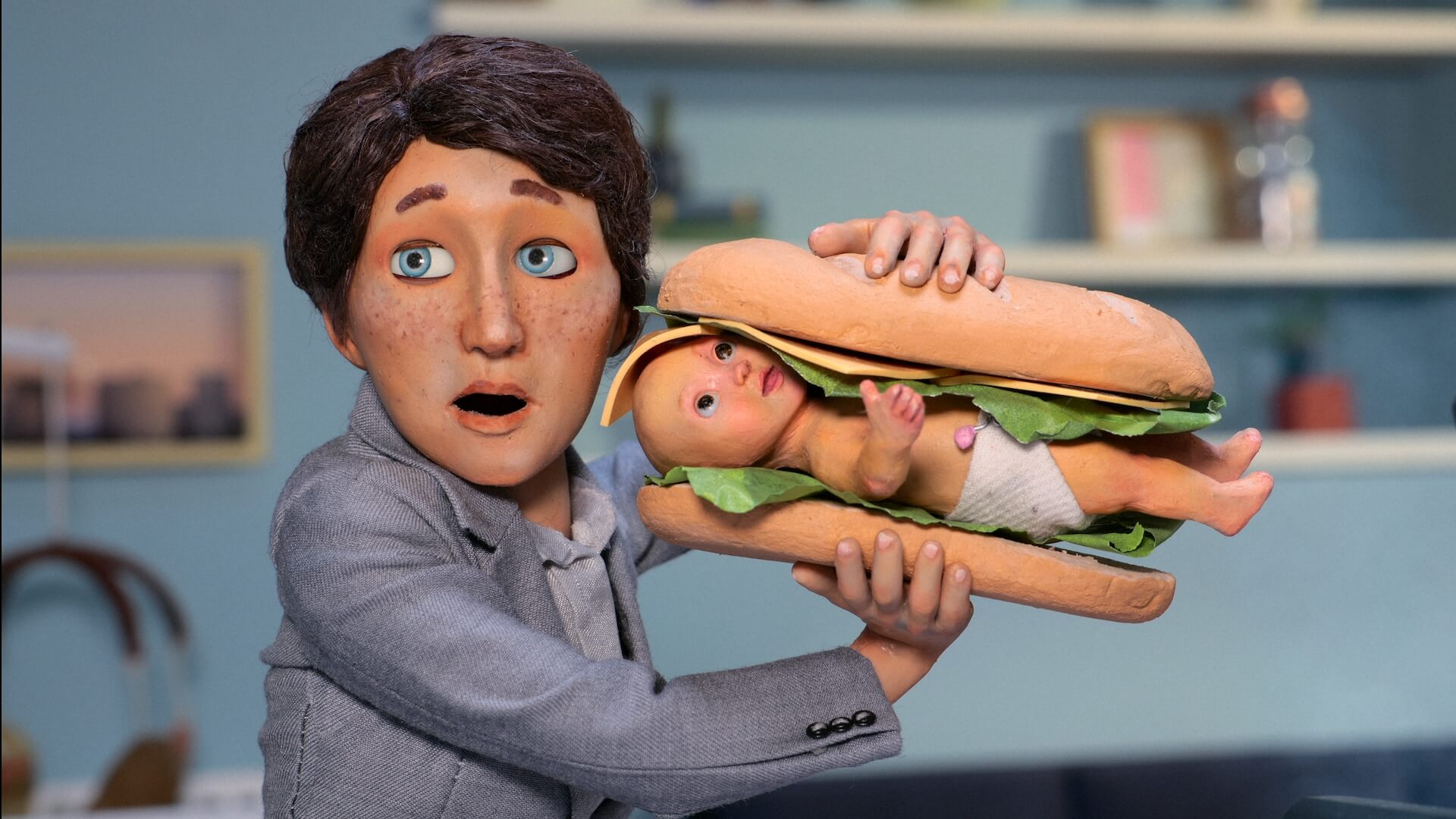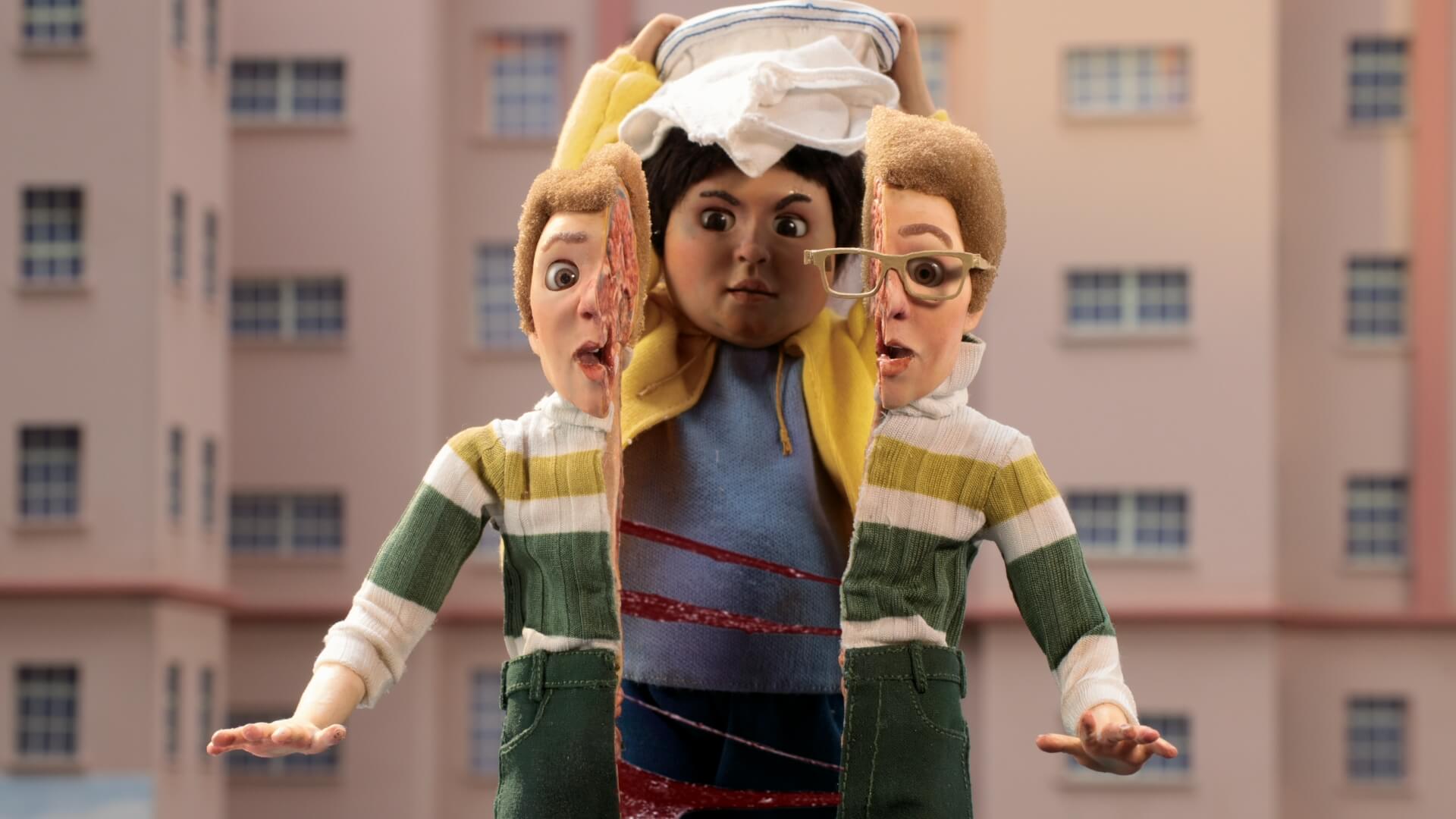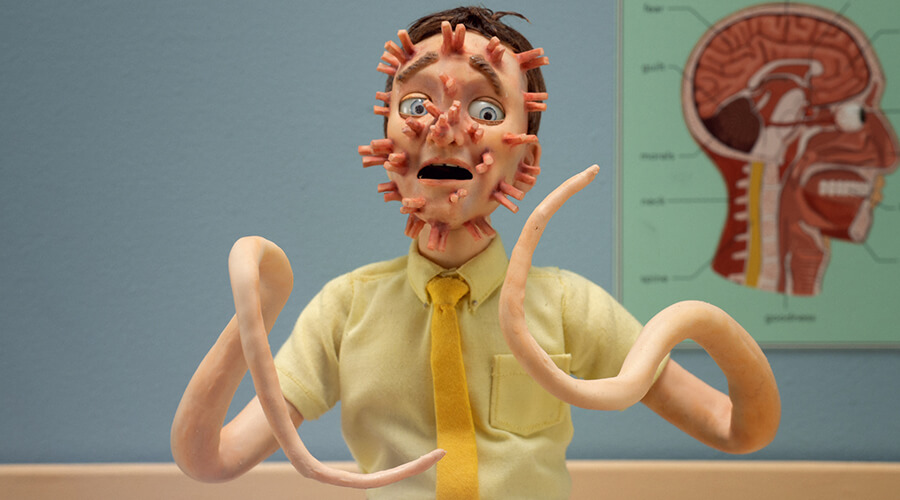The Shivering Truth: An Interview with director Cat Solen
Following a successful pilot that premiered roughly two years ago, the first season of The Shivering Truth aired on Adult Swim in December 2018 in the form of six compelling, quarter-hour instalments that left its audience chomping at the bit for more. This month has seen the series make its Stateside return, with season two kicking off this past weekend. Exec produced by Brooklyn collective PFFR (the team behind Wonder Showzen) and animated at Portland’s HouseSpecial, the show occupies a hypnagogic limbo between sketch comedy and a sleep paralysis nightmare whilst embracing stop-motion’s unique ability to straddle the line between technically astounding and disconcertingly uncanny.
THE SHIVERING TRUTH is a delicately crafted, darkly surreal anthology comedy. Each episode is a miniature propulsive omnibus cluster bomb of painfully riotous daymares all dripping with the orange goo of dream logic. A series of loosely linked emotional parables about stories within tales that crawled out of the deepest caverns of your unconscious mind and became lovingly animated in breath-slapping stop motion — in other words, it is the TRUTH (squared).
With the show’s second season having just kicked off in the US, Skwigly spoke with Cat Solen, who co-directs the series alongside writer/creator Vernon Chatman. Having built up a body of work that encompasses a variety of filmmaking methods (with puppetry a consistent recurring factor), Cat’s intuitive gift for grabbing viewers’ attention has seen her directing for – and working alongside – the likes of Sia, Michel Gondry, Joseph Gordon-Levitt, Tierra Whack, CSS and Bright Eyes, manifesting itself in music videos, television commercials, short films and a plethora of spots for Adult Swim.
What initially brought you and Adult Swim together?
My commercial work has always been, up until very recently, very scattered and a little strange. A lot of my work has been repeat clients, we just keep doing these lower budget projects that are great because they can be more experimental and more fun. Sometimes I don’t put them on my reel if they don’t lead me in the kind of direction as a filmmaker that I want to take, but it I do like the collaborative nature of commercial filmmaking and making commercials and ads. With music videos I’ve always been able to be super creative.
I had friends at Adult Swim, who sometimes do client-direct commercials that are low budget, very fast and usually you get the job, you make it, it airs for a week and then it’s gone. And they’re very product specific or demographic specific, based on something that needs to be advertised at that time, but the people that I worked with there, who do those kind of spots, are insanely creative and smart and fast and are some of my best friends now. The ads that I’ve made with them have been my favourites, I’m still so proud of them.

The Shivering Truth (Adult Swim)
Was it through this work at that ultimately led to you and Vernon working on The Shivering Truth?
I was already really good friends with Vernon before we started working on Shivering together, and we’d wanted to work together, so we talked very briefly about the ideas that he had, then I wrote up a bunch of concepts, and I sent them back to him and we pushed them further. Vernon’s really good at elaborating on an idea. Really what I love about working with him as a writer overall is that he’s always adding an Nth degree to a thing, you have your concept but then you put it inside of another box that then becomes another thing and another thing and another thing; I just love the way he can build out an idea and a theme.
We were already loosely talking about how one day we would make something but we didn’t know what. We were definitely always interested in anthology series and we definitely wanted to make something that was like, pushing the medium as far as it can possibly go, but within a limited budget capacity so that there would still be a lot of creative problem solving. We talked about real life stories, dreams we’d had, we talked about art, music, films that we loved, and we just started to establish this very strong language for filmmaking and art making. Now it’s one of the deepest creative relationships I have, it’s second nature to me to work with Vernon now, but it took us a good seven years to get to a place where we were like, “Okay, now we’re gonna make a show together”. And that’s when we finally made the pilot.
Vernon had worked with Adult Swim quite a bit, he loves them and has had several shows with them, so it felt like the perfect place to take for the show to exist – and they like us, so it worked! We feel very lucky to be there, we get to play around a lot, [Adult Swim] really embrace creativity, letting the filmmakers do their work, and they ask you really beautiful, awesome questions about what you’re making.

The Shivering Truth (Adult Swim)
The writing is fascinating, watching the show feels a bit like lucid dreaming – does it start with visual ideas that narration is written for later or is it the other way around?
It’s the other way around. Vernon will write these stream of consciousness stories that will have overarching themes to each episode. Then we sit together and dive very deeply into every single tiny part of the script, I’ll ask him 8 million questions about every single thing he’s picturing, and he knows it so well in his head that he doesn’t sometimes even have to look at the script.
So he writes these very elaborate, crazy, amazing visual things, then it’s my job and his to work together to figure out how to show them. A lot of times on the page, it’s like, How is this ever even going to be a visual thing? Like, how could this ever exist practically? You know what it feels like, you know it on a human level, emotionally, but practically it feels next to impossible. That is my favourite kind of thing to try to do, is try to make something that pushes stop motion through to a place where we haven’t seen it yet.
It’s so inspiring to me; I write a little bit and but there’s nothing for me that’s better than reading something for the first time and imagining it, visually, which I can’t do when I write it myself. So I absolutely love when I get to work with a writer like Vernon, it’s like the most amazing meal I’ve ever had in my whole life, because it’s so decadently rich, visually, in my head.
Can you tell us a bit about your role on the show and how an episode will come together?
Vernon and I sit together for as long as we can, before we even start production, we break down every single tiny thing from the whole entire show. My number one way to communicate is by drawing, so I’ll sit and draw little thumbnails, to try to show him what I’m imagining based on what he’s saying. So I’ll end up thumbnailing almost the whole show, they’re very rough and very strange, and some of the drawings are more detailed to see if it’s actually possible to shoot .
Then I usually go back to Portland (where production takes place at HouseSpecial) and I sit with the board artists, who elaborate on it and fill it all out. It’s a lot of work, articulating exactly what you want and being very clear, going back and forth with notes on those boards after they draw them. Next we do really super-detailed animatics for the show that we work on with the editor. We’re usually designing simultaneously with the boarding because we have all this really complicated blocking with the characters, so you have to know what the set looks like to know how to block it.
We have concept artists who are amazing, I work directly with all of them and we do all the design of the show in house. I’m so proud of how this season looks. I was really proud of the show already, but I can’t believe what we were able to pull off this season.
After we lock the animatic we don’t change anything, they’re so detailed, it’s very important to get those to be exactly what Vernon is imagining in his head. Then we start fabrication and I oversee all of that, from there we go on to shooting and there are about 15 stages running at once with about 12 to 13 animators, if we’re lucky. We don’t ever reshoot anything, everything we shoot is the first take so I have to make sure I’m really in touch with the animators.
After I get all the rig removal and assembly edits done then I pass it back to Vernon in New York – we have a team there that does extra visual effects stuff and all the final sound design and music.
You mentioned before that there was a limited budget capacity, but one thing that absolutely shines through is the quality and fluidity of the performances we see from each character…
I am so lucky to work with the animators that I get to work with, they’re so good. That’s the thing, sometimes when you work in animation people think that every job is just called ‘Animator’ and it’s not the case, because a good animator is so hard to find; I would never think of myself as a good animator, I’m not even close, but I know good animators that could get a performance out of a little rock that could make you cry! Not everybody has that ability and I really want people to know the difference between what an animator does and what I do, because they’re performers in and of themselves and I really appreciate getting to work with them.
Something I’m really proud of this year is that I made sure they had all the scripts and animatics upfront so that they felt the most connected to the characters and they also had a clear understanding of what was going on broadly within the show, because when they’re shooting they’re jumping into a random scene within a random episode and if they don’t have the context it’s not as strong as when they do. So I worked really hard this season to make sure that they really understood what they were animating and, and I think I think you can see it in the performances.
Vernon and I have had an idea of what the show would be for so long, deep down, that we do have an established language for the overall nature of the performance and the nature of the tone and the way that the characters act. There’s a certain school of comedy, like a Buster Keaton thing, that we both just love that we try to instill in the characters. Every now and then there’s a character who is extremely different, but for the most part they are these very dry, sad, emotional people.

The Shivering Truth (Adult Swim)
You mentioned earlier that you oversee fabrication – given your own background do you have any hands-on involvement in that side of things?
I feel like I say this all the time, so I don’t want to sound like I’m repeating myself, but it is a mantra that I live by that, as a director, I feel like a director’s job is to understand every job that other people are hired to do. They are specialists in that job, and they do that job better than you could on your own, so you work with them to let them do their job, you help them and give them the tools that they need in order to do it the best way that they can. And you listen to them when they tell you that something isn’t working. But you also have your own experience and your own language, enough to help them problem-solve when they hit roadblocks. So in that regard I’m extremely hands on. I don’t do my own sculpts (I have sculpted some of the characters in the show, but not this season) , but now I get to work with people who are better sculptors, who are more technically proficient, faster and have really good ideas that I wouldn’t have thought of – and it only helps make the show better to have them work with me.
So I do very distinctly understand the technical aspects of all of the things we are making, but I also really pride myself in letting people do that work with their own specialties and bring their own creative energy to it and have as much ownership over it as they want to.
In a lot of contemporary stop-motion production there’s a great deal of CG pre-vis, rapid-prototyping, that sort of thing. Would I be right in thinking that, from the look of The Shivering Truth, you’ve gone down a more traditional route?
We don’t really have the money or the time to do 3D printing, but we want them to look like puppets and we want it to look like a stop-motion show. Every day when I’m producing this show there are moments where I’m kicking myself, like Why did we do this? This was ridiculous. And then there are moments where I’m like, Oh my gosh, thank goodness, we did silicone puppets, there’s no other way we could have done this show with any other kind.
So it’s a back and forth constantly, and people never know what it is. I kind of like that a lot of times people call it ‘claymation’ – it’s definitely not, the majority of puppets are not claymation at all, they’re wire armatures and not ball and socket. They’re very complicated puppets where all the mechanisms are built in and they’re very specific to exactly what each character does. We try to make them as consistent as possible for the sake of production so that we don’t end up having each puppet be a totally new build, but they have to do such specific things – the main characters especially – that we end up building so many puppets. The amount of puppets and sets on this show is insane!

The Shivering Truth (Adult Swim)
With season two just about to kick off, how did you find the overall response to season one?
I was happily surprised with the way that people responded to the first season. To me it’s not dark, because I live within it, but when other people watch it they’re like “That’s a really dark show”!
It’s funny because I think we don’t quite conceptualise the show as a horror-type show, for us it’s a little more surrealist. Vernon and I are both really inspired by Tarkovsky and Bergman and Bresson, we don’t always think of ourselves as trying to make a horror show, but I absolutely love elevated horror movies – Midsommar, Get Out, those kind of movies – and I definitely want to make them.
I think people really liked the first season, and the second is a little more emotional and sad, but it also has a little more lightness that I am excited about. I can’t imagine watching this show with fresh eyes, and I wish I could. I wanna see it the way that audiences see it!
Hear more from director Cat Solen in an upcoming episode of the Skwigly Animation Podcast and see more of her work at catsolen.com
Season two of The Shivering Truth airs Sundays at midnight in the US on Adult Swim. Season one is available to UK viewers via All4; keep your eyes on Skwigly for updates on season two’s UK release.

